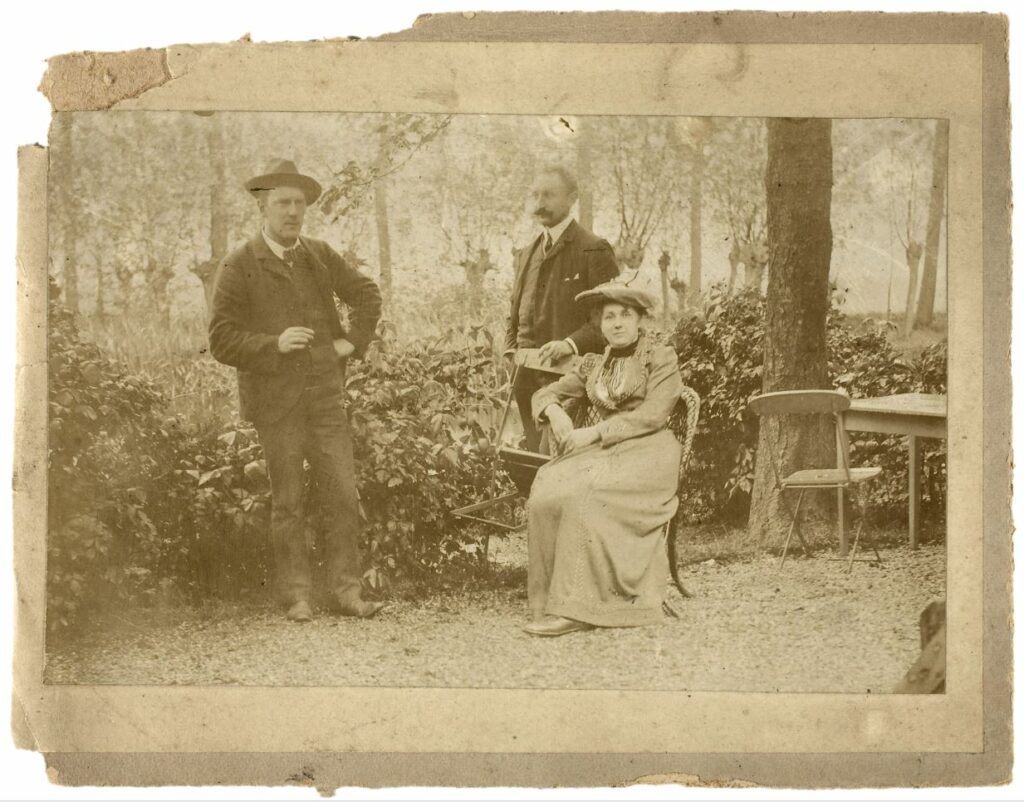by Jitske Lamain
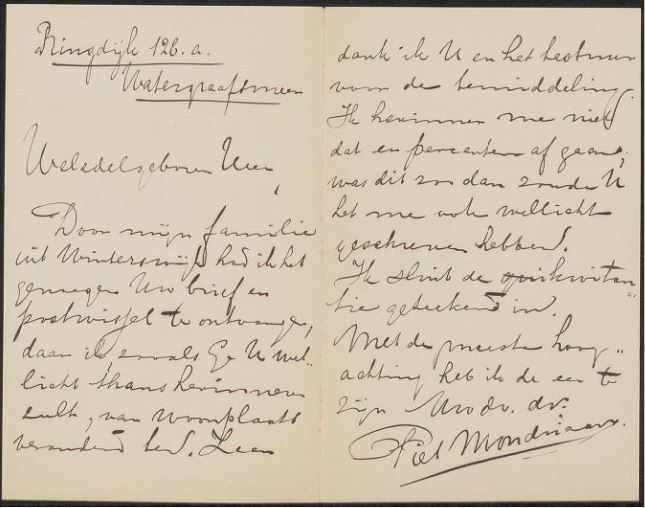
An increasing amount of letters by Mondrian has been handed down from around 1910 onwards. In these letters, Mondrian writes, among other things, about various artists societies he was a member of and exhibited his work. Whereas Mondrian writes with some regularity about the Moderne Kunstkring (est. 1910), and the Hollandsche Kunstenaarskring (est. 1913), correspondence from Mondrian to the Utrecht based society Kunstliefde (est. 1807) was not known until now. Recent archival research has resulted in the emergence of two letters from before the turn of the century, providing new information regarding Mondrian’s involvement with Kunstliefde. In one of the recently discovered letters to Kunstliefde, Mondrian writes about an artwork that was sold thanks to the mediation of the board, providing valuable insights into the conditions under which Mondrian exhibited his work (fig. 1).
Membership
On 11 February 1897, Mondrian writes to Kunstliefde: “Through my family in Winterswijk I had the pleasure of receiving your letter and postal order, since, as you may now remember, I have changed my residence.” Mondrian became a member of Kunstliefde as early as March 1892. At the time, he was still living with his family in Winterswijk and was not yet enrolled as a student at the Rijksakademie van Beeldende Kunsten (National Academy of Art) in Amsterdam, where he moved to in the fall of 1892 to begin his training as a painter. Kunstliefde was a society where it was fairly easy to become a member. Unlike at the Amsterdam based society Arti et Amicitae, Mondrian could work at Kunstliefde as a beginning artist without having to be nominated by another member, for example. The various opportunities that Kunstliefde presented, such as annual exhibitions, art viewings and drawing evenings, must have motivated Mondrian to become a member.
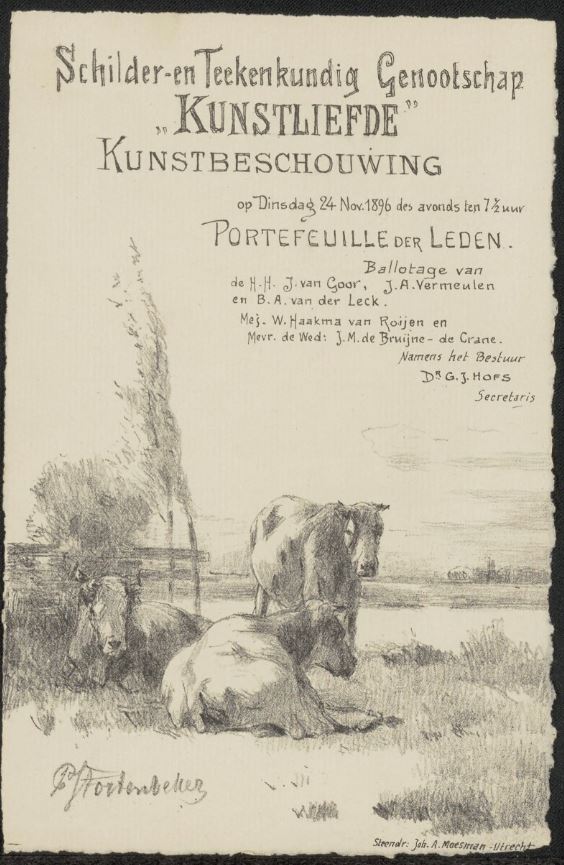
Art viewing and the circulating portfolio
Every year in November, Kunstliefde would organize an art viewing, a social gathering where members could exhibit their drawings and discuss the works on display. A selection of the works of the participants was then compiled into a circulating portfolio that travels to artists societies in other Dutch cities. Mondrian’s work was part of this circulating portfolio four times from 1896 onwards, namely in 1896/97, 1897/98, 1898/99 and 1900/1901. While Piet Mondrian: catalogue raisonné (1998) includes the general exhibitions organized by artists societies where Mondrian exhibited his work, it does not mention the art viewings and circulating portfolio, probably because this information was lacking when the catalogue appeared.
The artwork Kalm Leven
The letter that has been recently discovered, provides more information on the works that Mondrian has exhibited on these occasions, thanks to an attached receipt that has also been handed down. It includes the date, 11 February 1897, which allows us to date the letter as well. In combination with a price list of drawings included in the circulating portfolio in the society’s archives, it can be concluded that two of Mondrian’s artworks were part of it. This was the result of an art viewing of members’ work which took place on 24 November 1896 (fig. 2). The works included are the unidentified charcoal study Kalm leven (“Calm Life”) and Wijk aan Zee, after the Dutch seaside village bearing that name. The former was exhibited in the town of Almelo from 31 January to 5 February 1897 and subsequently sold there on 6 February 1897 for the sum of 25 Dutch guilders (fig. 3). In the absence of further leads, this work cannot be identified.
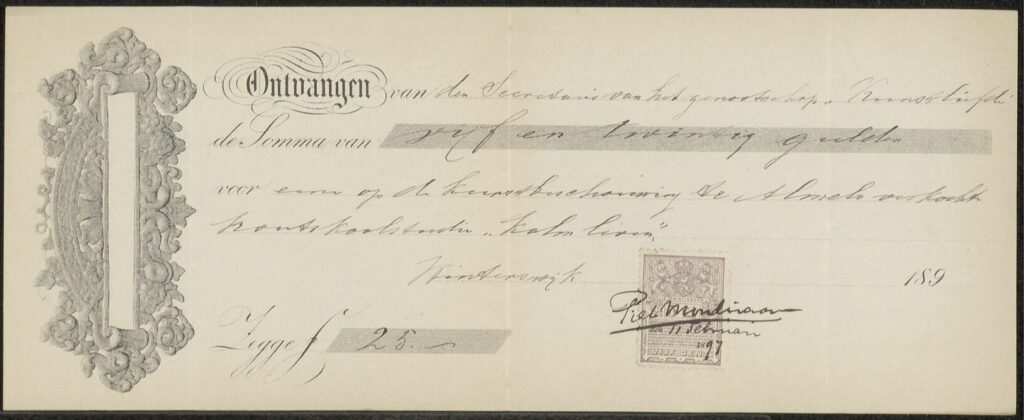
Wijk aan Zee
The second work that was exhibited, Wijk aan Zee, remained unsold as part of the circulating portfolio. At present, there is only one work remaining that Mondrian is known to have made in Wijk aan Zee (fig. 4). This is the oil sketch Wijk aan Zee (A162), dated ‘c. 1900-1901 (later?)’. This cannot have been the work that was shown at the Kunstliefde soirée, as the portfolio consisted solely of works on paper. The drawing cannot yet be identified, but there are several leads for further research. In 1939 Mondrian wrote to Max Dittmar Henkel (1879-1944) about an unidentified drawing he made during a visit to Wijk aan Zee: ‘It is quite possible that this drawing is mine because I did visit Mrs Seelig in Wijk aan Zee at the time and worked there a bit. I do still appreciate my early work and have even kept a few nude-drawings and some flower sketches’.
Eva Emmelina Seelig (1858-1930) was a German-Dutch artist for whom Mondrian designed several ex libris plates (Henkels 1987, p. 176). From other sources we know that Mondrian also gave Seelig drawing lessons (Bax 1994, p. 27; Henkels 1987, p. 176) (fig. 5). The ex libris plates that Mondrian designed for her are dated 1905. However, Bax suggests that they may also have been created earlier (Bax 1994, p. 41). In the letter to Henkel, Mondrian writes ‘having worked a bit’ in Wijk aan Zee. This suggests that Mondrian did not make a lot of works in Wijk aan Zee. It nevertheless seems likely that during the time he spent in Wijk aan Zee, Mondrian produced not only the oil sketch Wijk aan Zee but several drawings or other works, including the submitted drawing Wijk aan Zee as well. If this is indeed the case, the oil sketch and drawing titled Wijk aan Zee may also date from the same year as the art viewing, 1896. With this, the dating of the ex libris plates may well have to be reconsidered too. Their dating of c. 1905 was already tentative, before the information about Mondrian’s visit(s?) to Wijk aan Zee could be connected with it.
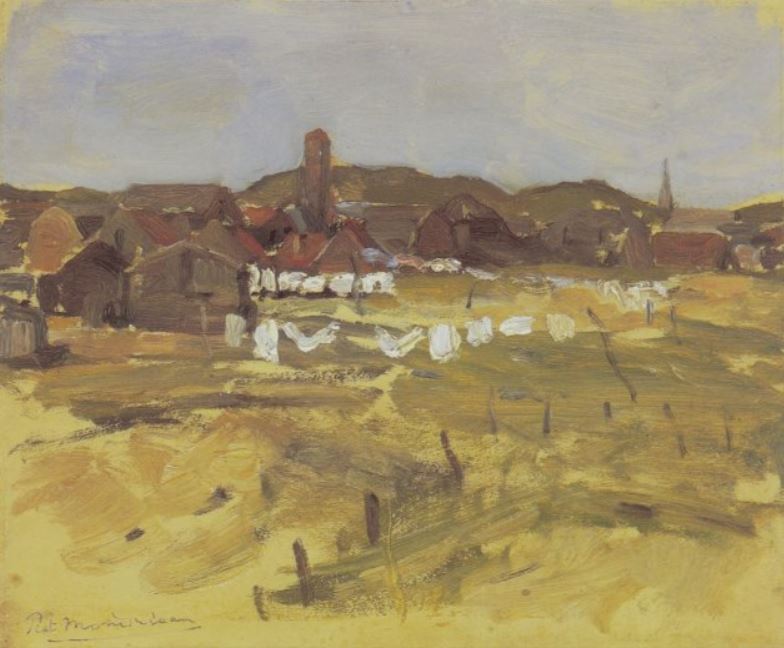
The starting point of Mondrian’s career
Despite the relatively modest exposure through Kunstliefde, the ‘aspiring painter’ Mondrian – as he called himself in a letter to Queen Regent Emma from 27 February 1892 – was able to exhibit his early work here and there and even sell some works. For an unknown artist, looking to broaden his horizon, this must have been a thrilling prospect. From 1909, by which time Mondrian’s work had undergone fundamental changes, he turned to exhibitions abroad and subsequently deregistered from Kunstliefde in 1910. Mondrian’s shift to the international art scene signaled his ambition and grown self-confidence, almost 20 years after joining Kunstliefde.
